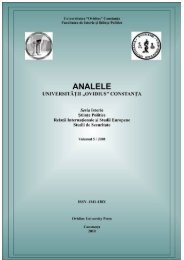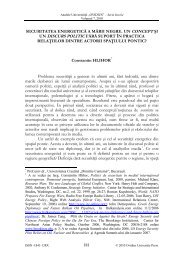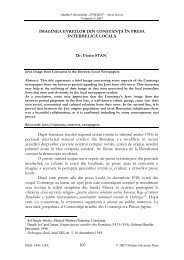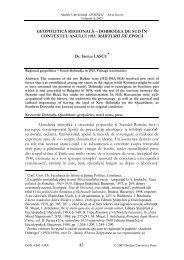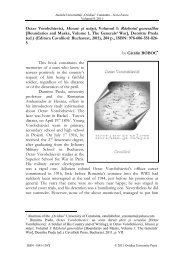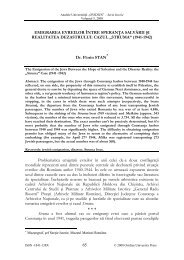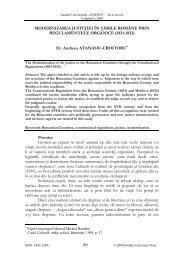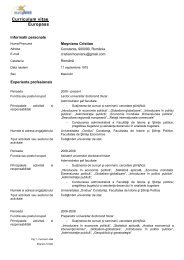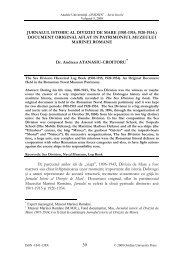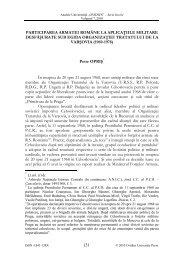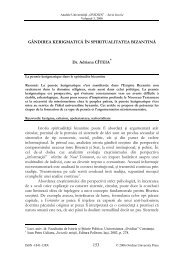analele universitÄÅ£ii âovidiusâ constanÅ£a - AUOCSI
analele universitÄÅ£ii âovidiusâ constanÅ£a - AUOCSI
analele universitÄÅ£ii âovidiusâ constanÅ£a - AUOCSI
You also want an ePaper? Increase the reach of your titles
YUMPU automatically turns print PDFs into web optimized ePapers that Google loves.
Luiza Filimon / Analele Universităţii „OVIDIUS” / Vol. 6/ 2009<br />
stability in the Balkans: the future of the Balkan states and the development of<br />
pan-Albanianism 17 .<br />
The war in Kosovo had both an immediate and a longer-term impact on<br />
the NATO Alliance. In the short term, it challenged the commitment and<br />
effectiveness of NATO leaders in ensuring security beyond Alliance borders. In<br />
the long term, ongoing Balkan conflicts (in Bosnia-Herzegovina, Kosovo,<br />
Serbia-Montenegro, and Macedonia) tested NATO’s cohesiveness and purpose.<br />
If we direct our attention towards the divided Bosnia-Herzegovina, we will<br />
observe that since the signing of the Dayton accords in the fall of 1995, Bosnia-<br />
Herzegovina has displayed uneven progress toward unification and multi-ethnic<br />
pluralism 18 .<br />
Nationalist forces and vested political and economic interests among all<br />
three ethnic groups have continued to obstruct the full implementation of the<br />
international agreement. The maintenance of a sizeable NATO presence was<br />
deemed essential to keep the peace and to apply political pressure on the<br />
feuding political leaders. Even though some moderate politicians were<br />
strengthened by the international community, nationalist leaders have continued<br />
to dominate, especially at local levels in the Serb entity and the Croat majority<br />
areas inside the Bosnian Federation 19 .<br />
In the ‘90, the debate revolved around issues of nationhood and national<br />
interest, ethnic minorities and the right of self-determination 20 . By 1992, a<br />
retrogression had become noticeable, because of the following factors:<br />
Yugoslavia had disintegrated and the danger of a spill-over war was everpresent;<br />
the democratization and liberalization path in the ex-communist<br />
countries from the Balkans had been slower and aroused negative international<br />
reactions; economic aid from Western Europe and especially from the<br />
European Union, was not sufficient to boost the East European economies. In<br />
addition, the "occidental" economies in the region, like those of Greece and<br />
Turkey seemed deficient and ineffective in helping significantly the neighboring<br />
economies 21 . On the other hand, after 1990, Balkan trade had and has been<br />
energized. After a period of significant decline (1980-1988) the economies of<br />
Balkan countries tried to delve into new markets and the new possibilities of<br />
liberalization of the economy 22 .<br />
17 Ibidem.<br />
18 Tom Gallagher, ”The Balkans in the New Millenium”, Publishing House Humanitas,<br />
Bucureşti, 2005, p. 113.<br />
19 Ibidem, pp. 114-116.<br />
20 Haralambos Kondonis, “Prospects for Balkan cooperation after the disintegration of<br />
Yugoslavia”, East European Quarterly, Fall, 1998, p.22 accessed: November, 22, 2009, at:<br />
http://findarticles.com/p/articles/mi_7063/is_n3_v32/ai_n287<br />
23284/.<br />
21 Ibidem.<br />
22 Ibidem, p.26.<br />
ISSN -1841-138X 82 © 2009 Ovidius University Press



